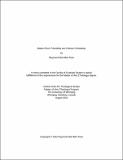| dc.contributor.author | Poon, Raymond Wai-Man | |
| dc.date.accessioned | 2022-08-19T16:35:47Z | |
| dc.date.available | 2022-08-19T16:35:47Z | |
| dc.date.issued | 2022-08-16 | |
| dc.identifier.citation | Poon, Raymond Wai-Man. Matteo Ricci: Friendship and Chinese Christianity; A thesis submitted to the Faculty of Graduate Studies in partial fulfillment of the requirements for the Master of Arts (Theology) degree, United Centre for Theological Studies, The University of Winnipeg. Winnipeg, Manitoba, Canada: University of Winnipeg, August 2022. DOI: 10.36939/ir.202208191129. | en_US |
| dc.identifier.uri | https://hdl.handle.net/10680/2013 | |
| dc.description.abstract | In the late sixteenth century CE, Macau was a fishing village located on China's south. Ruled by the Ming Dynasty (1368–1644), a fleet of ships had anchored in the village’s docks. China had limited foreign visitors. However, the Portuguese had arrived. The Portuguese wanted to export the European Catholic knowledge and culture to this unfamiliar land. The Portuguese colonial structure was hoping to assimilate the orient to Christianity. The Portuguese Missionary priests arrived. Matteo Ricci (1552–1610), a Jesuit priest, arrived in Macau in 1582 CE to introduce Christianity to Chinese society. At that time, Ming China followed Confucian ideology for their social guidance. Ricci realized that in order to communicate with the Chinese government officials, who held influential positions, he must learn the Chinese language and culture. Ricci gained essential communication skills from reading and translating the Four Books, which were Chinese Classics. Ricci developed friendships with some government officials by sharing his knowledge of science and technology. As his last strategy, Ricci combined European Christianity theology and Cicero’s De Amicitia. He analyzed and synthesized Confucian terminologies to write Discussion of Friendship, his foundational book. Ricci’s book contains the sole purpose of his journey: to create a movement fermented in China’s influential groups leading to the spread of Christianity. Even though Ricci did not build a physical church in China, Ricci successfully introduced Christianity to China, and laid the foundation for the European and American missionary work. He did this through friendship—gaining friends in China, earning their support, and writing Discussion of Friendship. | en_US |
| dc.language.iso | en | en_US |
| dc.publisher | University of Winnipeg | en_US |
| dc.rights | info:eu-repo/semantics/openAccess | en_US |
| dc.subject | Ricci, Matteo | en_US |
| dc.subject | Discussion of Friendship 交友論 | en_US |
| dc.subject | China -- Ming Dynasty | en_US |
| dc.subject | Christianity | en_US |
| dc.title | Matteo Ricci: Friendship and Chinese Christianity | en_US |
| dc.type | Thesis | en_US |
| dc.description.degree | Master of Arts in Theology | en_US |
| dc.publisher.grantor | University of Winnipeg | en_US |
| dc.identifier.doi | 10.36939/ir.202208191129 | en_US |
| thesis.degree.discipline | Theology | |
| thesis.degree.level | masters | |
| thesis.degree.name | Master of Arts in Theology | |
| thesis.degree.grantor | University of Winnipeg | |

